April 23, 2025 | 03:22 GMT +7
April 23, 2025 | 03:22 GMT +7
Hotline: 0913.378.918
April 23, 2025 | 03:22 GMT +7
Hotline: 0913.378.918

Fresh feed utilized by lobster farmers can cause environmental pollution. Photo: Kim So.
Scheduled for November 15, 2023, the Ministry of Agriculture and Rural Development will host the Forum on "State of Breeding Stock, Feed, and Aquaculture Supplies; Tracing Product Origin and Sustainable Development Solutions for Vietnam's Aquaculture" in Nha Trang city, Khanh Hoa province.
Forum Agenda: Management of lobster breeding stock, sustainable lobster farming solutions; Tracing the origin of lobsters and aquaculture products to meet market demands; Control of imported aquaculture breeding stock; Research and production of industrial feed, various supplies for aquaculture; the state of the seafood market at year-end and projected outlook for 2024.
According to Khanh Hoa province's Department of Agriculture and Rural Development, by the end of 2022, the province had 68,666 lobster farming cages, with a total yield of over 1,375 tons. The total number of lobster farming cages in the province has risen to 74,330 in the first ten months of 2023, with a total yield of over 1,517 tons.
Cam Binh commune, Cam Ranh city, is one of the primary lobster farming areas in Khanh Hoa province. The commune currently houses over 400 rafts and 20,000 cages in service of lobster farming, with an average yield of 300 tons per year, primarily comprising blue lobsters.
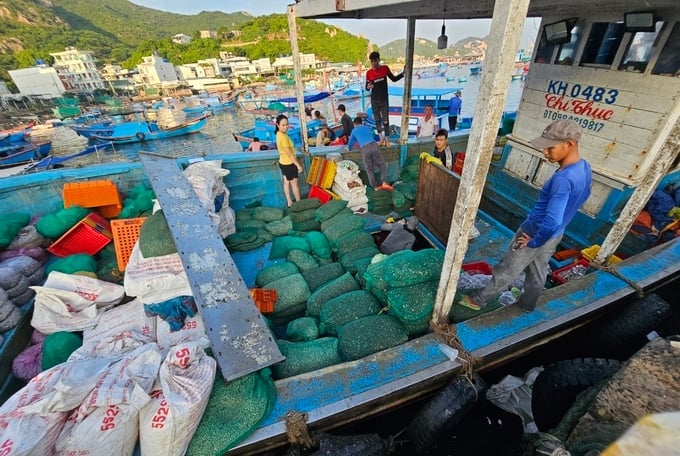
Busy view of lobster feed trading activities on Binh Ba island, Cam Binh commune, Cam Ranh City, Khanh Hoa province. Photo: Kim So.
The trading activities for lobster feed is relatively busing during the early morning on Binh Ba island, Cam Binh commune, Cam Ranh City, Khanh Hoa province.
According to local farmers, nearly ten fishing vessels deliver various types of lobster feed including cuttlefish, scad fish, squid, conchs, whelks, etc. for the lobsters. Smaller vessels can carry between 15 and 20 tons of feed, whereas larger vessels can transport between 40 and 50 tons. The feed is sold at an average price ranging from 5,000 to 10,000 Vietnamese dong per kilogram, up to 28,000 to 30,000 Vietnamese dong per kilogram depending on the type.
Mr. Nguyen Van Phuong in Binh Ba Tay hamlet, Cam Binh commune, shared that newly released lobsters are typically fed with expensive items such as squid, which is priced at roughly 60,000 to 70,000 Vietnamese dong per kilogram, or shrimp. After farmed lobsters reach five years of age, they are provided a variety of feed based on the budget and preferences of the farmers. For each lobster cage holding 400 to 500 blue lobsters, the daily feeding cost, including snails and fish, amounts to approximately 170,000 to 200,000 Vietnamese dong. Mr. Phuong's family, with a total of 50 lobster farming cages, incur an expense of approximately 10 million Vietnamese dong per day.
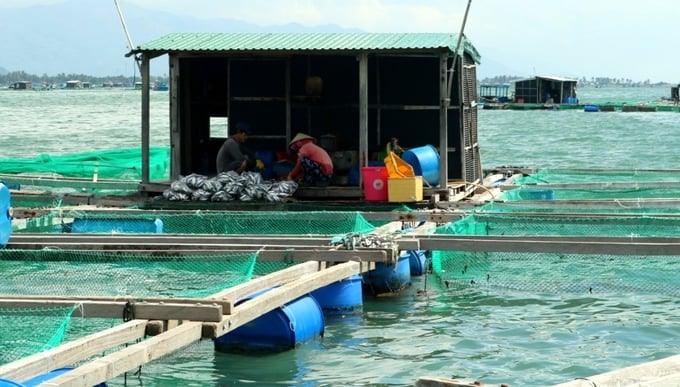
Lobster farming using fresh feed carries hidden risks of disease. Photo: Kim So.
Mr. Nguyen Duy Quang, Director of the Khanh Hoa province's Department of Agriculture and Rural Development, stated that current lobster farming relies heavily on fresh feed sourced from coastal regions, consisting of miscellaneous fish, small crustaceans, and soft-bodied animals such as clams and snails. The use of fresh feed in lobster farming not only affects coastal aquatic resources but also gives rise to environmental concerns. Consequently, Mr. Quang emphasized the necessity for solutions to proactively manage the feed sources for lobster farming.
In agreement with Mr. Quang's viewpoint, Mr. Nguyen Tri Phuong, Deputy Director of the Phu Yen province's Department of Agriculture and Rural Development, stressed that the use of miscellaneous fish as feed for lobsters poses risks of disease contamination and preservatives. Additionally, uncollected excess feed is directly discharged into the sea, thereby causing environmental pollution.
"Over time, the accumulated food waste forms a layer of black mud on the seabed, causing pollution and posing the risk of disease outbreaks, resulting in mass lobster deaths, such as the incident of mass farmed lobster deaths in Xuan Dai Bay in June 2017," recalled Mr. Phuong.
Lobster farmers in Phu Yen and Khanh Hoa provinces are primarily utilizing outdated raft farming methods. The cages are constructed from wooden frames enclosed in mesh, measuring between 9 to 16 square meters, suspended on wooden rafts and supported by floating plastic drums.

The outdated lobster farming rafts used by local residents are susceptible to damage during strong winds and waves. Photo: Kim So.
According to Mr. Pham Ngoc Luyen, Deputy Head of the Van Ninh district's Economic Department, the rudimentary farming cages can only function effectively and briefly in areas with slow currents and minimal wave activity, leading to a low investment efficiency. Moreover, these rudimentary cages pose a risk to farmers during storms and heavy waves.
The impact of Typhoon Damrey in 2017, which struck Khanh Hoa Province, demonstrated this risk by devastating traditional wooden farming cages, causing substantial economic losses to aquaculture farmers. According to Mr. Pham Ngoc Luyen, this storm led to the near-complete destruction of over 50,000 aquaculture cages in the district.
Similarly, towards the end of 2021, lobster farmers on Binh Hung island, Cam Binh commune, Cam Ranh city, Khanh Hoa Province also suffered severe losses due to the impact of Typhoon 9. Additionally, the cold air generated large waves and strong winds, resulting in significant damage to numerous farming cages.
Witnessing the sorrow of these farmers, losing their harvest due to the destruction of the lobster farms, is undoubtedly a heartbreaking sight. An once active farming area suddenly turned desolate, devastated by the waves, leaving a heap of wreckage, with numerous barrels, wooden frames scattered across the sea.

Farming cages on Binh Hung island, Cam Binh commune, Cam Ranh city, Khanh Hoa province, severely destroyed by large waves in 2021. Photo: Kim So.
According to a report from the Cam Binh Communal People's Committee, Typhoon No. 9 caused heavy damages to 2,472 farming cages, including 573 spiny lobster farming cages and 1,899 blue lobster farming cages in Binh Hung Hamlet. Additionally, 82 rafts were damaged to varying degrees from 20% to 100%; 2 vessels and 1 canoe sank, resulting in an estimated total damage of 384 billion Vietnamese dong.
In response to the environmental pollution caused by the mixed diet of lobsters, the research and development of industrial feed for lobsters are considered vital. Subsequently, Dr. Mai Duy Minh from the Research Institute for Aquaculture III has successfully established an industrial feed production process for lobster farming since 2016, through the use of ingredients such as fishmeal, wheat flour, soybean meal, bran, and squid meal.
According to Dr. Mai Duy Minh, the recent practice of feeding lobsters in tanks in Khanh Hoa and Phu Yen provinces with industrial feed has yielded positive results. Namely, the survival rate and product quality of blue lobsters, including color and evenly textured meat, are ensured, similar to those raised on fresh feed. On the other hand, the growth of spiny lobster is relatively slower under an industrial feed diet. The Feed Conversion Ratio (FCR) in farming tanks falls between 2 and 2.2 for blue lobsters and stays at 3.0 for spiny lobsters. However, the FCR for spiny lobsters can be adjusted to range between 2.6 and 2.8 with good management efforts.

The Research Institute for Aquaculture III has successfully established an industrial feed production process for lobster farming. Photo: Kim So.
"Regarding the assured quality of industrial feed for lobsters, even lobsters displaying a weakened state when transferred from rafts to tanks undergo a healthy molting process. Furthermore, this feed exhibits good adhesion, a pleasant odor, and maintains a standardized Feed Conversion Ratio ranging from 2.2 to 3.0, with a cost of approximately 130,000 Vietnamse dong per kilogram. Consequently, a kilogram of lobsters will cost less than 400,000 Vietnamse dong, which I believe to be a very reasonable investment," affirmed Dr. Minh. He further added that substituting fresh feed with industrial feed in lobster farming not only mitigates disease outbreaks and environmental waste but also significantly contributes to responsible harvesting practices to safeguard aquatic resources.
Following the successful lobster farming model using industrial feed in tanks, Dr. Mai Duy Minh will continue researching to find suitable solutions for using industrial feed in lobster farming cages at sea, where water currents reduce the lobsters' capacity to detect food and unwanted surface fish compete with lobsters for feed. Additionally, farmers can assess the efficiency of industrial feed for lobsters and gradually transition to deploying this model for industrial lobster farming at sea.
Mr. Huynh Kim Khanh, Director of the Khanh Hoa province's Agricultural Extension Center, highlighted the necessity of converting traditional rafts to HDPE cages for adaptation to natural disasters. In practice, HDPE cages withstand rough weather conditions more effectively compared to wooden rafts. When Typhoon Damrey struck Khanh Hoa province, despite the extensive damages to local wooden rafts, the HDPE cages belonging to Australis Vietnam Aquaculture Company and the High Technology Aquaculture Center under Research Institute for Aquaculture I remained largely unaffected.
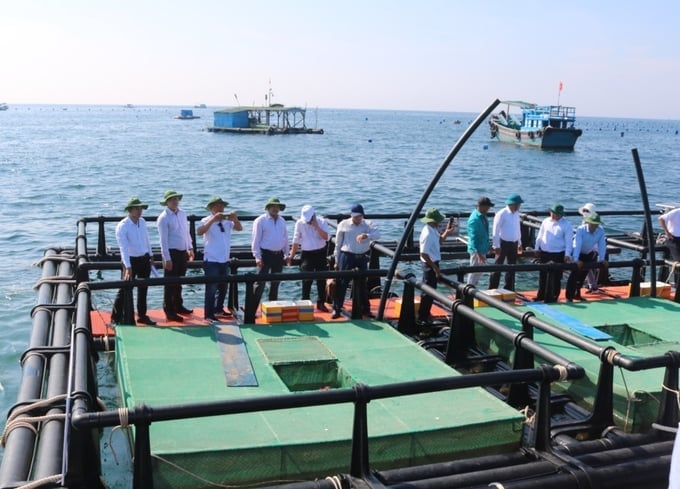
Khanh Hoa province has implemented a lobster farming model using HDPE cages. Photo: Kim So.
To assist farmers in adopting HDPE cages, the Khanh Hoa province's Agricultural Extension Center has implemented numerous models in the Van Phong Bay area to relatively positive results. In addition to the environmental benefits and the prevention of deforestation for wooden cage construction, this model has also bolstered the confidence of farmers during heavy rain and stormy weather. The cage design allows for optimal aeration, leading to better growth and development of lobsters and other aquatic species, minimizing disease outbreaks and environmental pollution. Moreover, due to the longevity of HDPE cages - up to 50 years - the total expenses over the entire cycle remain more cost-effective compared to that of wooden cages.
The Khanh Hoa province's Department of Agriculture and Rural Development recently collaborated with the Thien Tam Fund under Vingroup Corporation to support ten pioneering households in adopting advanced technologies for aquaculture in the Cam Ranh Bay area. Namely, six households have received assistance to farm lobsters within square HDPE cages measuring 4 by 4 by 3.5 meters. These cages are equipped with surveillance cameras and a sea positioning system, allowing farmers to remotely monitor operations via electronic devices. Throughout the pilot farming process, the cage structures are continuously adjusted to align with the natural conditions and needs of local fishermen.
Translated by Nguyen Hai Long
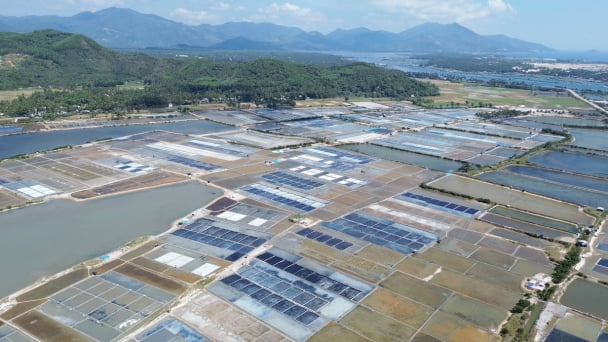
(VAN) On April 22, the United Nations Development Program (UNDP) worked with a group of local farmers from Tuyet Diem village and representatives of Xuan Binh commune, Phu Yen province.

(VAN) At the close of the P4G Summit, delegates agreed to transform agricultural and food systems sustainably, ensuring food security while protecting the environment.
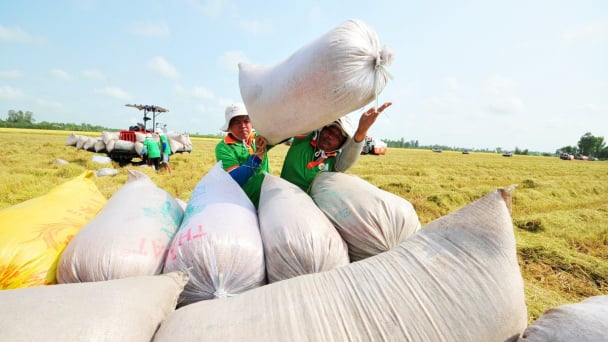
(VAN) The rice industry in the Mekong Delta is undergoing a major transformation, shifting toward sustainable, high-quality, and low-emission exports to meet the green and clean standards increasingly demanded by international markets.
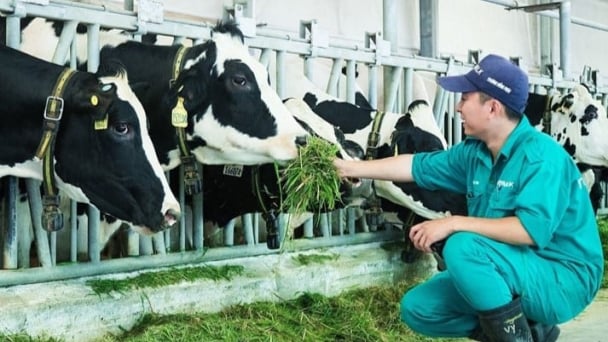
(VAN) According to Tong Xuan Chinh, Deputy Director of the Department of Livestock Production and Animal Health, Vietnam’s dairy cattle industry must overcome seven major challenges to achieve sustainable development.
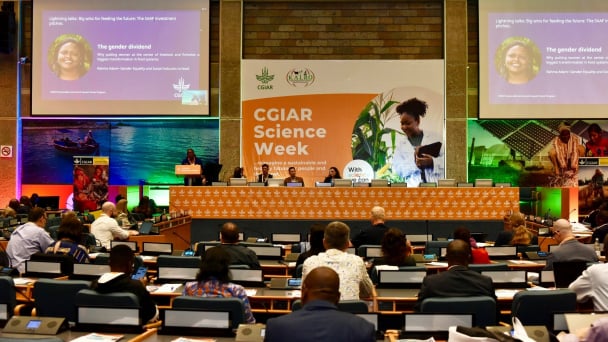
(VAN) The CGIAR’s Sustainable Animal and Aquatic Foods (SAAF) program represents a new approach that emphasizes the transformation of food systems toward sustainability.
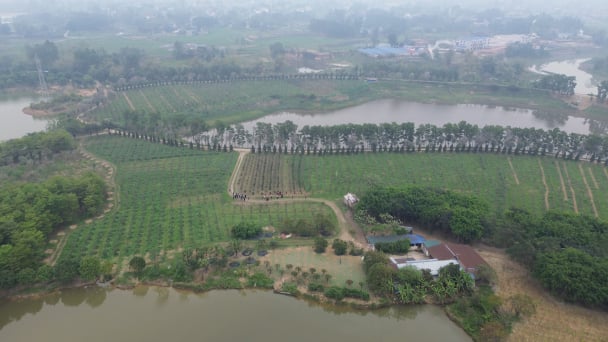
(VAN) Scientists assume that industrial agriculture has been 'outdated.' As a result, a comprehensive overhaul or a revolution in the direction of embracing ecological agriculture is needed.
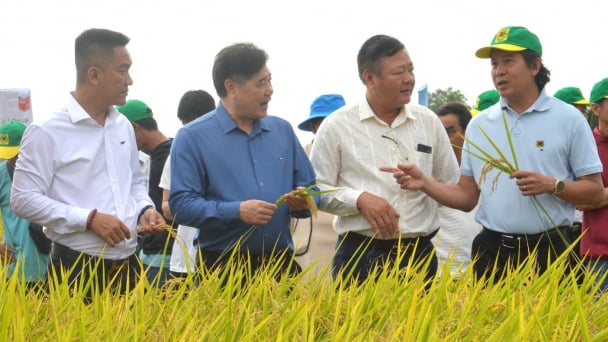
(VAN) The results from pilot fields are catalyzing the expansion of the One million hectares of high-quality, low-emission rice project in Kien Giang.